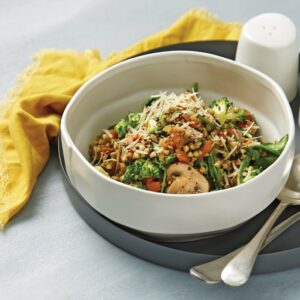
Vegan and vegetarian diets have grown in popularity over the past decade and now the term ‘plant based’ is bandied around on café menus, social media feeds and supermarket shelves. But what are the differences between veganism, vegetarianism and plant-based eating? Healthy Food Guide founding editor Niki Bezzant explains.
Here’s what we cover:
- What plant-based means
- How to be vegetarian
- What veganism is
- How to stay healthy on a plant-based diet
It can be confusing when we hear the term ‘plant based’ when it comes to diets. The term has been used to describe many different ways of eating. So, what do they all mean – and which is best for you?
What is ‘plant based’ anyway?
There’s no real official definition of a plant-based diet.
Looking at it literally, a plant-based diet is a diet that is based on plants; a way of eating that is mainly plant foods such as vegetables, fruit, grains, nuts, legumes and seeds.
Nutrition experts point out that plant-based diets can also include animal-derived foods such as fish, meat and dairy. The well-regarded Mediterranean diet is an example of this sort of plant-based diet. It’s a diet that’s firmly based on plants, but also features small amounts of other animal foods, and is widely acknowledged to be a great diet for health and longevity.
This type of plant-based diet might also be described as a flexitarian diet or a semi-vegetarian diet. Someone who eats no meat but eats fish – known as a pescatarian – is also likely eating a plant-based diet.
Other diets are also described as plant based. They include diets that are plant only, such as a vegan diet, and diets that include some animal foods but not meat, such as a vegetarian diet.
What is a vegetarian diet?
A vegetarian diet is based on plant foods and excludes meat, poultry and fish. Vegetarian diets include:
- vegetables
- fruit
- nuts
- seeds
- grains
- legumes
They may also include:
- eggs
- dairy foods
A vegetarian diet that includes eggs is known as ovo-vegetarian, and a vegetarian diet that includes dairy is lacto-vegetarian. These can be combined (ie, including both eggs and dairy) as lacto-ovo vegetarian.
Experts say a well-planned vegetarian diet – with or without eggs and dairy – can be a healthful way of eating that offers a good range of nutrients, vitamins and minerals.
It’s important for vegetarians to replace protein from meat sources with other forms of protein, to ensure they get enough. This is especially important for older vegetarians to help maintain muscle strength and mobility. Tofu, legumes, nuts, seeds, eggs, yoghurt and wholegrain bread are good options to include help meet daily protein targets.
Also, iron from plant sources can be harder to absorb than animal-sourced iron so it’s a good idea for vegetarian women and children to keep an eye on this nutrient and include vitamin C-rich foods at meals to aid non-haem iron absorption.
Browse our amazing vegetarian recipes.
What is a vegan diet?
Another plant-based way of eating, a vegan diet is similar to a vegetarian diet, in that it excludes meat, poultry and fish. But it goes further to exclude all other animal foods. Many vegans also avoid animal products in other areas of their lives, including beauty products, shoes and clothing.
A vegan diet includes:
- vegetables
- fruit
- nuts
- seeds
- grains
- legumes
A vegan diet excludes:
- meat
- poultry
- fish
- eggs
- dairy
- insects
- insect foods such as honey
Experts say a well-planned vegan diet can be a healthful way of eating, too. But extra care needs to be taken to make sure you’re getting all the nutrition you need, including protein, calcium and vitamin B12 and iron especially. These are things we typically get from animal foods such as meat, fish, dairy and eggs, and getting them without those foods in the diet can be more difficult – though it’s by no means impossible.
One vitamin vegans might need to consider taking as a supplement is vitamin B12. This is only found in animal foods, so can be difficult to get in a diet without them. Vitamin B12 might be in some foods that are fortified, such as cereals or plant milks.
For delicious vegan recipes head here.
How to get the best out of your plant-based diet
All of the above types of plant-based diets can be healthy and highly nutritious. But like other eating patterns they can also be unhealthy and low in nutrition, depending on the types of food you include.
If you’re eating too much highly-processed food – whether vegan, vegetarian or otherwise – you’re not giving your body the best possible nourishment. It’s just as possible to have a poor-quality vegetarian or vegan diet as it is to have a poor-quality meat-based diet.
So, whichever plant-based way of eating you go for, make sure you stick to these basic principles:
- Choose whole foods first – go for unprocessed vegetables and fruits as much as possible. With other plant foods, go for minimally processed versions and whole grains
- Eat your colours – eat tons of colourful foods from the above food groups
- Go for variety – make sure your diet includes a wide variety of different foods so you get the widest possible range of nutrients.
For more on vegan, vegetarian and plant-based diets you might be interested in: How to choose vegan cheese alternatives or Help my teen has just turned vegetarian
Article sources and references
- Scimex, 9 May 2021. Differences in health-related biomarkers profile of vegetarians and meat-eaters: A cross-sectional analysis of the UK Biobank study. Accessed June 2021https://www.scimex.org/newsfeed/vegetarians-have-healthier-disease-markers/multimedia/EP3-33vegetarians.pdf
- Kahleova H, Klementova M, et al (2017) The Effect of a Vegetarian vs Conventional Hypocaloric Diabetic Diet on Thigh Adipose Tissue Distribution in Subjects with Type 2 Diabetes: A Randomized Study, Journal of the American College of Nutrition, 36:5, 364-369, DOI: 10.1080/07315724.2017.1302367https://www.tandfonline.com/doi/full/10.1080/07315724.2017.1302367
- Jenkins D, Spence D, et al.Supplemental Vitamins and Minerals for CVD Prevention and Treatment, Journal of the American College of Cardiology, Volume 71, Issue 22,2018, https://doi.org/10.1016/j.jacc.2018.04.020.https://www.sciencedirect.com/science/article/pii/S0735109718345601?via%3Dihub#bib5
- Heart Foundation. Plant-based, vegetarian and vegan diets. Accessed June 2021https://www.heartfoundation.org.nz/wellbeing/healthy-eating/nutrition-facts/plant-based-vegetarian-vegan-diets
- Heart Foundation. Dietary patterns and the heart - Evidence paper. Accessed June 2021https://www.heartfoundation.org.nz/resources/dietary-patterns-and-the-heart-evidence-paper
- Milfont T, Satherley N, et al. To meat, or not to meat: A longitudinal investigation of transitioning to and from plant-based diets. Appetite, Volume 166, 2021, https://doi.org/10.1016/j.appet.2021.105584.https://www.sciencedirect.com/science/article/abs/pii/S0195666321004918
- health.gov. Scientific Report of the 2015 Dietary Guidelines Advisory Committee. June 2021https://health.gov/our-work/food-nutrition/previous-dietary-guidelines/2015/advisory-report
- Gardner CD, Trepanowski JF, Del Gobbo LC, et al. Effect of Low-Fat vs Low-Carbohydrate Diet on 12-Month Weight Loss in Overweight Adults and the Association With Genotype Pattern or Insulin Secretion: The DIETFITS Randomized Clinical Trial. JAMA. 2018;319(7):667–679. doi:10.1001/jama.2018.0245https://jamanetwork.com/journals/jama/fullarticle/2673150
- Harvard School of Public Health. The Best Diet: Quality Counts. Accessed June 2021https://www.hsph.harvard.edu/nutritionsource/healthy-weight/best-diet-quality-counts/
- Katz D.L and Meller S. Can We Say What Diet Is Best for Health? Annual Review of Public Health 2014 35:1, 83-103https://www.annualreviews.org/doi/10.1146/annurev-publhealth-032013-182351
www.healthyfood.com










